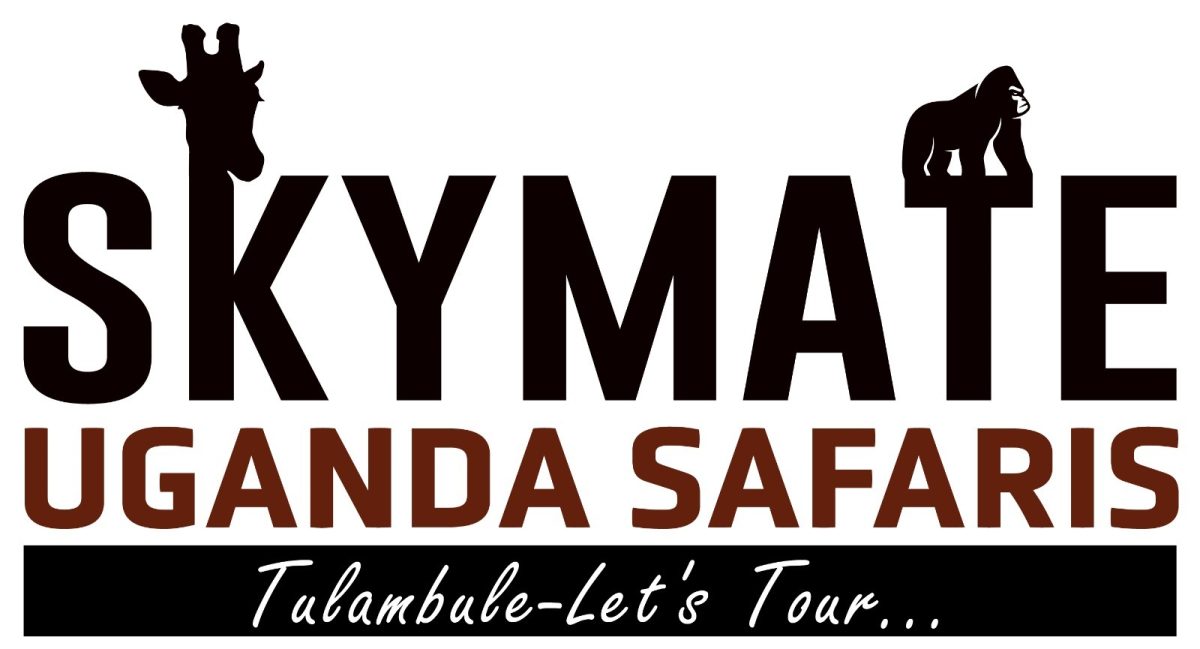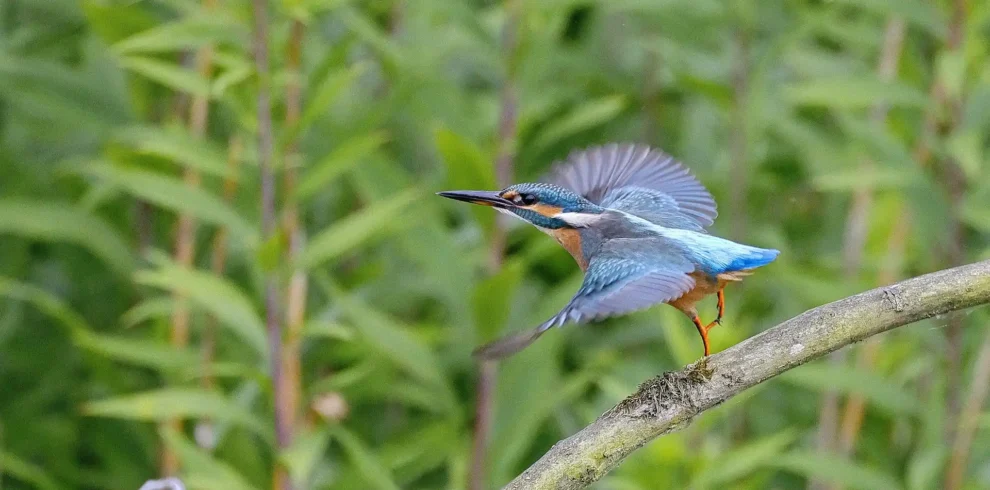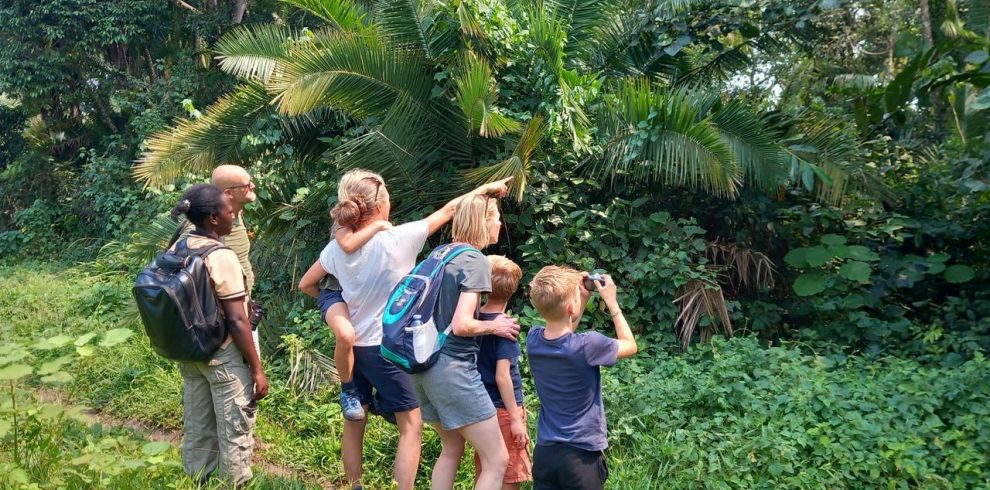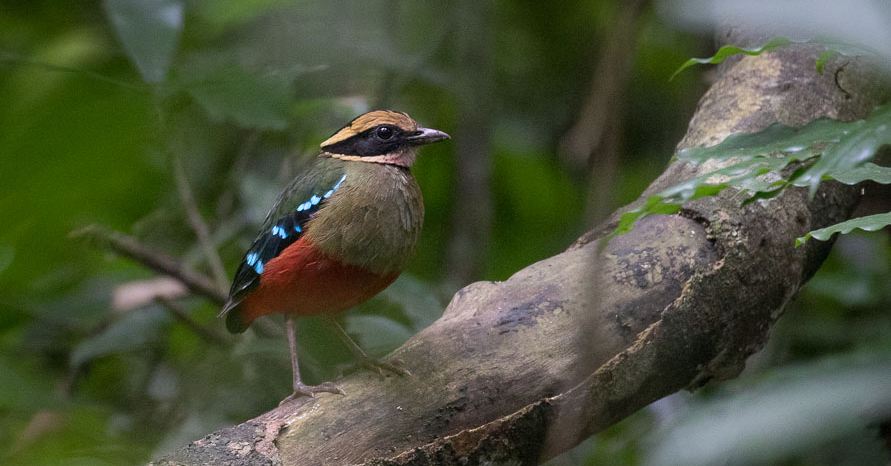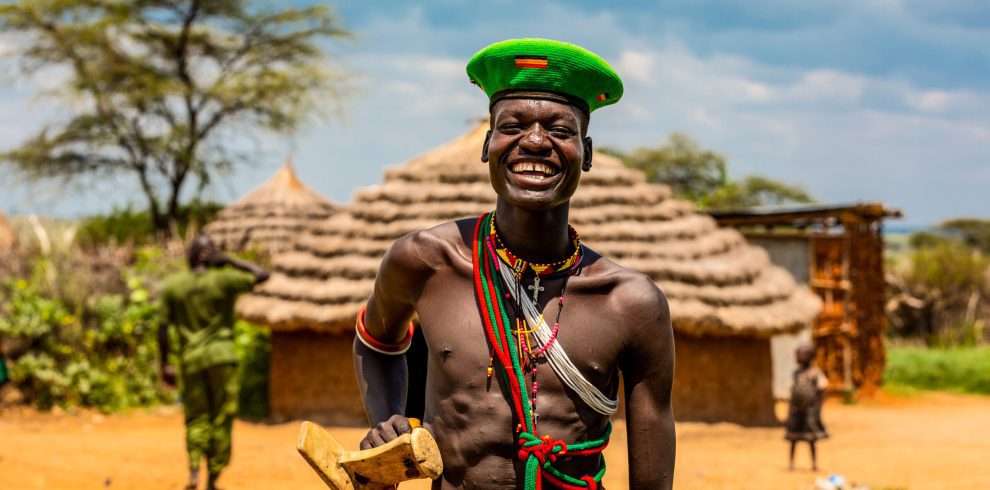This 17 Days Uganda Birding Tour and mammal extravaganza allows you to find the most important birds and primates of Uganda.
The Shoebill stork is almost guaranteed. Over 20 Albertine Rift endemics are also sought, including one of Africa’s most fabulous turacos, Rwenzori Turaco, African Green-breasted Pitta and of course the “must-see” Grauer’s Broadbill.
We also look for other range-restricted Uganda birds, such as Red-faced Barbet. Ross’s Turaco, Great Blue Turaco (almost twice the size of other turacos), and various other birds are virtually garden birds here in Uganda, “the Pearl of Africa”.
Other highlights of our 17 Days Uganda birding tour are a great many primates such as Uganda Red Colobus, Guereza, Mountain Gorilla, and Chimpanzee, not to mention the spectacular scenery, including such famous places as Lake Victoria (Africa’s largest lake), River Nile (the world’s longest river), and Bwindi Impenetrable Forest.
The latter part of this tour is good for a host of more widespread African birds, Lion, Elephants, Buffaloes, Hippos, Crocodiles with some luck Leopard, and fabulous sites such as Murchison Falls, where the mighty Nile is forced through a narrow gap.
17 Days Uganda Birding Tour Summary
Day 1: Arrival in Entebbe and Birding the Shore Of Lake Victoria
Days 2: Shoebill and transfer to Masindi
Day 3: Birding at Budongo Forest’s beautiful Royal Mile, transfer to Murchison Falls.
Days 4: Murchison Falls National Park
Day 6: Murchison Falls to Masindi – Kaniyo Pabidi Forest
Day 7: Masindi to Kibale National Park
Days 8– 9: Kibale National Park/Fort Portal – the Chimpanzee/Green-breasted Pitta combo
Day 10: Kibale to Semuliki National Park and back to Fort Portal
Day 11: Fort Portal to Queen Elizabeth National Park
Day 12: Queen to Bwindi Impenetrable National Park
Days 13: Ruhija, Bwindi Impenetrable Forest
Days 14-15: Buhoma, Bwindi Forest: birds and optional gorilla trekking
Day 16: Bwindi to Lake Mburo National Park
Day 17: Lake Mburo to Entebbe and Departure
17 Days Uganda Birding Tour Details
Day 1: Arrival in Entebbe and Birding the Shore Of Lake Victoria
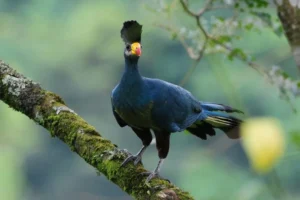
We will pick you from Entebbe International Airport and transfer to a nearby guest house before starting the birding. The striking Double-toothed Barbet as well as the dazzling Black-headed Gonolek are both common around Entebbe. African Hobby and Bat Hawk are sometimes seen around town.
Palm-nut Vulture, Broad-billed Roller, numerous weavers, and perhaps our first Great Blue Turaco might be seen as we bird the Entebbe Botanical Garden on the shore of Africa’s largest lake.
Overnight: The Boma, or similar, Entebbe
Meal Plan: Dinner
Days 2: Shoebill and transfer to Masindi
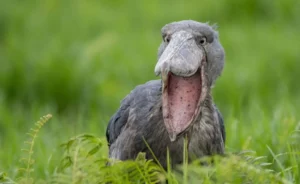
Our day will start with an early breakfast in the hotel. After that, we will visit the legendary Mabamba Swamp, about an hour drive to the north.
This 16,500-hectare wetland on the shores of Lake Victoria is an essential stop on any Uganda birding tour, recognized as a Ramsar Wetland of International Importance.
It is Africa’s most accessible site for spotting the iconic Shoebill, Uganda’s most famous bird. With its prehistoric appearance, large yellow eyes, and a bill resembling a shoe, it’s no surprise that this bird is high on every birder’s wish list.
During this segment of your Uganda birding tour, we’ll also search for papyrus swamp specials, including the Red-chested Sunbird, several weaver species known for their intricately neat nests, coucals, and tropical waterbirds like the Lesser Jacana. The wetlands are also teeming with Swamp Flycatchers, adding to the excitement of our dugout canoe trip into the expansive swamp.
After encountering the Shoebill, we’ll embark on a scenic 5-hour drive northwest, pausing for lunch en route. Our destination is Masindi, a charming rural town and a popular stopover on the journey to Murchison Falls National Park, where the next leg of your Uganda birding tour awaits.
We will rest, enjoy a delicious dinner and stay overnight at our comfortable lodge after a great first day in Uganda.
Day 3: Birding at Budongo Forest’s beautiful Royal Mile, transfer to Murchison Falls.
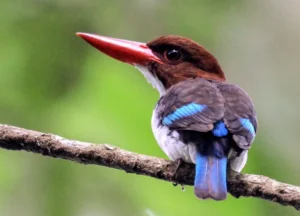
Budongo Forest is exceptional for many special birds. Chestnut-capped Flycatcher is a star bird. There is also a trio of small warbler-like flycatchers that are taxonomically enigmatic. Fraser’s Forest Flycatcher is another prized bird in Budongo.
The Budongo Royal Mile is a must-visit destination on any Uganda birding tour, renowned for its dazzling variety of kingfishers. While not all of these vibrant birds are associated with water, the Chocolate-backed Kingfisher steals the spotlight as the most sought-after species.
Other stunning kingfishers you may encounter include the African Dwarf Kingfisher and the Blue-breasted Kingfisher, ensuring a memorable experience.
Forest-floor birding reveals treasures like Fire-crested Alethe, Red-tailed Ant Thrush, and the elusive Nahan’s Partridge, while the canopy offers sightings of species such as the charming Rufous-crowned Eremomela and White-thighed Hornbill. The forest is also alive with fantastic barbets, woodpeckers, and tinkerbirds.
An intriguing feature of the Budongo Royal Mile during your Uganda birding tour is the presence of numerous greenbul species. These fascinating birds inhabit varying levels of the forest, from the undergrowth to the canopy, making them a delight to observe and identify.
The Royal Mile is a awesomely beautiful forest to spend time in and surely boasts an extremely rich birdlife. From here we will transfer to Murchison Falls, Uganda’s largest and oldest national park.
Overnight: Murchison River Lodge or Similar
Meal Plan: Breakfast, Lunch & Dinner
Days 4: Murchison Falls National Park
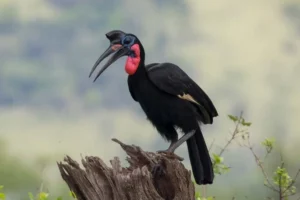
As part of your Uganda birding tour, we’ll embark on a scenic boat cruise to the base of the majestic Murchison Falls. This thrilling excursion not only offers breathtaking views but also allows us to add numerous bird species to our growing list.
The area is excellent for spotting mammals of all sizes, including Giraffes, Elephants, Buffalos, Lions, Leopards, Oribi, Hartebeests, Warthogs, Waterbucks, and the rare Patas Monkeys.
Birding enthusiasts on the Uganda birding tour can look forward to sightings of remarkable avian species, such as Silverbird, Speckle-fronted Weaver, Black-headed Lapwing, Abyssinian Ground Hornbill, Red-throated Bee-eater, Rock Pratincole, White-headed Barbet, Swallow-tailed Bee-eater, Black-billed Barbet, Meyer’s Parrot, and Bateleur.
The dramatic Murchison Falls, where the massive Nile River is forced through a narrow 8-meter gap before plunging 45 meters below, is a highlight of this experience. While enjoying the stunning view, there’s a chance to spot elusive species such as Pel’s Fishing Owl or Bat Hawk.
Additionally, if possible, a night drive can be arranged to seek nightjar and owl species, including Long-tailed, Plain, and Pennant-winged Nightjars, as well as the Greyish Eagle-Owl.
This segment of your Uganda birding tour promises unforgettable wildlife and birding encounters amid spectacular natural scenery
Overnight: Murchison River Lodge or Similar
Meal Plan: Breakfast, Lunch & Dinner
Day 6: Murchison Falls to Masindi – Kaniyo Pabidi Forest
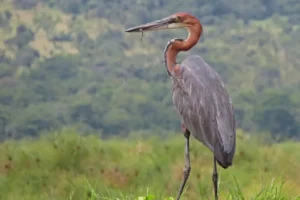
Our Uganda birding tour begins with an early breakfast, followed by a thrilling boat cruise to the delta area of the park. As we sail along the legendary Nile River’s tranquil waters toward the Albert Delta, you’ll have the chance to spot iconic species, including the elusive Shoebill.
Other exceptional birds to look out for include Pel’s Fishing Owl, Long-toed Lapwing, Saddle-billed Stork, Red-throated Bee-Eater, Western Banded Snake Eagle, Goliath Heron, and African Darter.
Along the way, you’ll encounter hippos swimming in the water and elephants and crocodiles lounging on the shores. The boat trip concludes at the confluence of the Victoria and Albert Nile, a remarkable location where the Victoria Nile flows south into Lake Albert before continuing to South Sudan and onward to the Mediterranean Sea in Egypt.
After the boat tour, our Uganda birding tour continues with exciting game drives, culminating in a packed picnic lunch on the banks of the Nile. A visit to the top of Murchison Falls adds yet another highlight to the day.
If time permits, we’ll stop in the Kaniyo Pabidi section of the Budongo Forest to search for the rare Puvel’s Illadopsis, the only known East African site for this elusive forest dweller. Here, we may also find other lowland forest specials, such as the Western Crested Guineafowl, Spotted Greenbul, African Dwarf Kingfisher, Blue-breasted Kingfisher, Forest Robin, and Yellow-mantled Weaver.
We will then proceed to the guesthouse where we stayed two nights ago, enjoying dinner and some well-earned relaxation after a busy and rewarding birding day.
Overnight:
Meal Plan: Breakfast, Lunch & Dinner
Day 7: Masindi to Kibale National Park
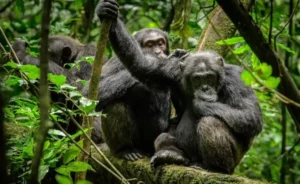
We start the day with a hearty breakfast before setting off on a picturesque drive south to the Albertine Rift area.
This 5 to 6-hour journey is sure to pass quickly, thanks to the breathtaking landscapes along the way. Around lunchtime, we will arrive in Fort Portal, a charming town in one of the most scenic regions of Uganda.
Although the fort that gave Fort Portal its name no longer stands, the town remains a highlight of any Uganda birding tour due to its natural beauty and unique surroundings.
We will enjoy lunch at one of best restaurants in town. After lunch we’ll transfer to Kibale Forest National Park, about an hour to the south.
Overnight: Kibale Forest Lodge or Similar
Meal Plan: Breakfast, Lunch & Dinner
Days 8– 9: Kibale National Park/Fort Portal – the Chimpanzee/Green-breasted Pitta combo
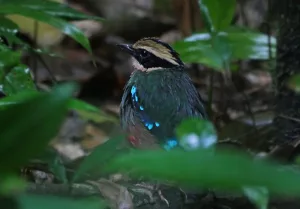
During this part of your Uganda birding tour, our primary focus will be locating the elusive Green-breasted Pitta, a remarkable bird best spotted at dawn.
Its unique display call helps us pinpoint its whereabouts—otherwise, despite its jewel-like colors, finding it amidst the forest floor can feel like searching for a needle in a haystack.
As we navigate the forest in search of this avian gem, the atmospheric and somewhat eerie sounds of large chimpanzee troops echo through the trees, adding a thrilling element to this unforgettable segment of your Uganda birding tour.
There is also the chance for optionally trekking for Chimpanzees. We should also find some other primates such as Uganda Red Colobus, Blue monkeys, Black-and-white Colobus, Red-tailed Monkey, and other monkeys (not to mention the well-built Olive Baboon, which wanders around in massive groups, usually on the ground).
We also have a lot of good birds to see, which might include Narrow-tailed Starling, Black-billed Turaco, White-headed Wood Hoopoe, and Chestnut Wattle-eye.
Overnight: Kibale Forest Lodge or Similar
Meal Plan: Breakfast, Lunch & Dinner
Day 10: Kibale to Semuliki National Park and back to Fort Portal
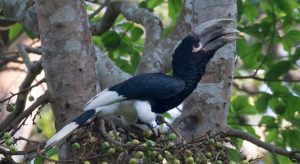
After an early breakfast, we’ll grab our binoculars and head west to a very special park. We are going to have a full birding day in Semuliki National Park. It is a 2 hour drive with incredibly scenic views along the way.
The Semuliki National Park is a highlight of any Uganda birding tour, offering a unique extension of the West African jungle into East Africa. This 219 km² forest park is contiguous with the DR Congo’s great Ituri Forest, creating a rare habitat for Guinea-Congo biome species found nowhere else in East Africa.
Renowned for its incredible biodiversity, the park boasts over 440 bird species, including 50 species exclusive to this region. The Semuliki National Park is also home to primordial hot springs, adding a mystical charm as we navigate its trail networks in search of avian wonders.
On this part of the Uganda birding tour, we’ll target Guinea-Congo biome specialties, including the Congo Serpent Eagle, Oberländer’s Ground Thrush, and the elusive Nkulengu Rail.
Other treasures include the Spot-breasted Ibis, Long-tailed Hawk, and forest gems like the Lyre-tailed Honeyguide, Crested Malimbe, and African Piculet.
Forest-edge birding reveals even more species, including the striking Red-rumped Tinkerbird, Blue-billed Malimbe, and the endemic Pale-fronted Nigrita. For bird enthusiasts on the Uganda birding tour, the diversity of Semuliki’s birdlife ensures an unforgettable experience.
After our amazing day in this very special patch of forest we will drive back to our hotel in Fort Portal for relaxation, dinner and overnight.
Day 11: Fort Portal to Queen Elizabeth National Park
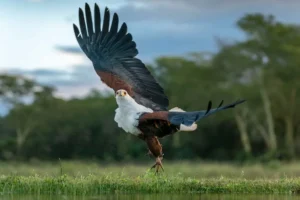
We will have a leisurely breakfast today, before we depart and head south to Queen Elizabeth National Park. It is a drive of approximately 2 to 3 hours, depending on how many stops we make along the way to spot some more birds.
We’ll arrive at our lodge in time for lunch. Afterward, we will embark on a short game drive, immersing ourselves in the wonders of this iconic location as part of the Uganda birding tour.
Officially opened by England’s queen in 1954, this park is renowned for its tree-climbing lions and boasts an incredible diversity of 100 mammal species and 612 bird species.
A major highlight of this leg of the Uganda birding tour is the opportunity to explore the Kazinga Channel by boat. Here, you’ll encounter crocodiles, hippos, and a wide array of waterbirds.
Other wildlife sightings typically include warthogs, buffalo, the graceful Uganda Kob, and many other fascinating mammals. The Forest Hog, however, often steals the spotlight with its impressive presence.
Day 12: Queen to Bwindi Impenetrable National Park
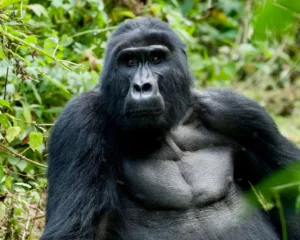
After an early breakfast, we will depart Queen Elizabeth National Park and head even further south as part of the Uganda birding tour.
Before leaving the park, we will embark on a thrilling game drive through the Ishasha sector in the Rukungiri District, searching for the renowned tree-climbing Lions.
These majestic lions, known for their unique black-maned males, are often spotted resting on fig tree branches while scanning the open plains for prey.
We will enjoy lunch somewhere along the route as we continue to Africa’s richest forest for primates and birds, Bwindi Impenetrable National Park, and stay in its high-altitude Sector of Ruhija.
Overnight: Gorilla Forest Camp or Similar
Meal Plan: Breakfast, Lunch & Dinner
Days 13: Ruhija, Bwindi Impenetrable Forest

We’ll start birding the forest-covered hills of Ruhija during this remarkable Uganda birding tour, searching for the striking Black Bee-eater and the elusive Grauer’s Swamp Warbler, which can be found in the lower reaches of Mubwindi Swamp. This warbler can often be spotted at a roadside site, helping to shorten the walk. Along the way, the Mountain Yellow Warbler might also be seen, offering an interesting comparison with the Papyrus Yellow Warbler.
The walk down to Mubwindi Swamp cannot be skipped, as it provides an opportunity to encounter the sought-after Grauer’s Broadbill, one of Africa’s most desired species. The beautiful and localized Yellow-eyed Black Flycatcher also inhabits the bottom reaches of the forest, adding to the excitement.
This part of the Uganda birding tour is considered one of the best days for birdwatching, with participants often spotting a constant stream of life birds, especially Albertine Rift endemics. Highlights include Banded Prinia, Mountain Masked Apalis, Rwenzori Apalis, Chestnut-throated Apalis, the peculiar Grey-throated Barbet, Red-faced Woodland Warbler, and several vivid crimsonwings, showcasing the colorful forest finches of the region.
Other exciting species you may encounter on this Uganda birding tour are the Olive-breasted Greenbul, the exceptionally long-tailed Blue-headed Sunbird, the radiant Regal Sunbird, and restricted-range birds like the Stripe-breasted Tit and Rwenzori Batis. Additionally, more widespread yet equally spectacular birds such as the magnificent Bar-tailed Trogon and the Rwenzori Hill Babbler further elevate the experience.
Overnight: Gorilla Forest Camp or Similar
Meal Plan: Breakfast, Lunch & Dinner
Days 14-15: Buhoma, Bwindi Forest: birds and optional gorilla trekking
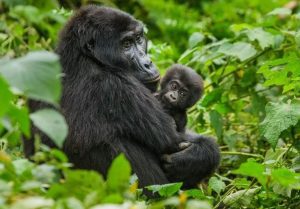
As part of your Uganda birding tour, we’ll explore the area between Ruhija’s high-altitude forests and Buhoma’s lower-elevation sections, with an exciting birding stop at “The Neck.”
This location offers the chance to spot species unique to this region, such as the stunning Black Bee-eater, Chubb’s Cisticola, and Cinnamon-chested Bee-eater, which are quite easy to find.
During this stop on the Uganda birding tour, we may also encounter the charismatic Black-and-white Shrike-flycatcher, recognizable by its striking crest and contrasting plumage. Additionally, Mackinnon’s Shrike, Brown-throated Wattle-eye, and Bronzy Sunbird could make an appearance, along with the African Grey Woodpecker and the soaring Augur Buzzard.
Delving into the deep forest, our search will focus on localized endemics, such as Grauer’s Warbler, Bar-tailed Trogon, Petit’s Cuckooshrike, Lühder’s Bushshrike, Brown-capped Weaver, and Red-throated Alethe. These avian treasures are an integral part of the Uganda birding tour experience, showcasing the area’s biodiversity.
We’ll also seek out slightly more widespread species, like the elusive White-spotted Flufftail, Red-shouldered Cuckooshrike, Olive-bellied Sunbird, and vibrant forest barbets such as the impressive Yellow-billed Barbet. The dazzling African Emerald Cuckoo and the striking Black-billed Turaco add even more excitement to this journey.
The Uganda birding tour offers equally rewarding forest-edge birding opportunities, perfect for photography. Here, specials like Dusky Long-tailed Cuckoo, Great Blue and Ross’s Turaco, Black-necked Weaver, Northern Double-collared Sunbird, and Grey-headed Nigrita can be found. Over two full days, we’ll immerse ourselves in birding across forest trails, edges, and nearby agricultural zones.
At Buhoma itself, there is the chance for one day optionally gorilla trekking.
Overnight: Haven Lodge Buhoma or Similar
Meal Plan: Breakfast, Lunch & Dinner
Day 16: Bwindi to Lake Mburo National Park
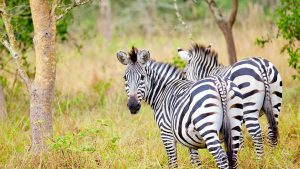
After an early breakfast, we will head northeast towards our final park of this fantastic 17 Days Uganda birding tour, Lake Mburo National Park. The drive to the northeast will take about 5 hours, but we will still look for birds, and make rest stops as needed.
We will enter the Lake Mburo National Park through the Sanga Gate. Just outside the park we will come across some of the world-famous long-horned Ankole cattle of the Bahima people that live in the area – always a highlight and worthy of a few photos.
We eventually arrive at Lake Mburo National Park (where we’ll spend two nights), which breaks the journey between Entebbe and Bwindi. Lake Mburo is home to over 300 bird species and 68 species of mammals.
We will reach our lodge and check in, followed by a superb late lunch. We will end our day with an afternoon/early evening game drive in the park.
Overnight: Rwakobo Rock or Similar
Meal Plan: Breakfast, Lunch & Dinner
Day 17: Lake Mburo to Entebbe and Departure
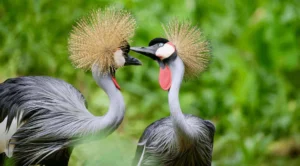
Today, as part of your Uganda birding tour, we will embark on an exciting boat cruise on the lake, one of the best spots to find the elusive African Finfoot.
During this journey, we may also spot overwintering species like the Malagasy Pond Heron and the vibrant Papyrus Gonolek, along with an impressive variety of kingfishers.
These include the beautiful Malachite Kingfisher, the majestic Giant Kingfisher, the common yet striking Pied Kingfisher, and the rare and exquisite Shining-blue Kingfisher.
The park provides incredible opportunities to encounter arid-country birds, such as the Blue-naped Mousebird and the unique Bare-faced Go-away-bird.
Birders will be thrilled to seek out the highly localized Red-faced Barbet, considered “thin-on-the-ground,” as well as the widespread yet captivating Spot-flanked Barbet.
This day promises memorable sightings and adds immense value to your Uganda birding tour, leaving you with an unforgettable birding experience.
Nubian Woodpecker is often heard before it is seen. Like in most arid-habitat parks in East Africa a large bird list can be accumulated very fast, and the above species are just a few of the many goodies we expect to find.
This is the only place where we’re likely to see Plains Zebra during our Uganda birding tour, and there are a lot of other mammals as well, such as Hippopotamus, African Buffalo, Defassa Waterbuck, Bohor Reedbuck, Topi, and Common Eland.
After the boat cruise we will embark on the transfer to Entebbe, about 4 to 5 hours away.
We will make a photo stop at the Ugandan Equator crossing at Kayabwe, where you can stand with one leg in the Northern hemisphere while the other remains in the Southern! It is also an impressive site for buying souvenirs to take back home as a memento of this incredible 17 days Uganda birding tour.
